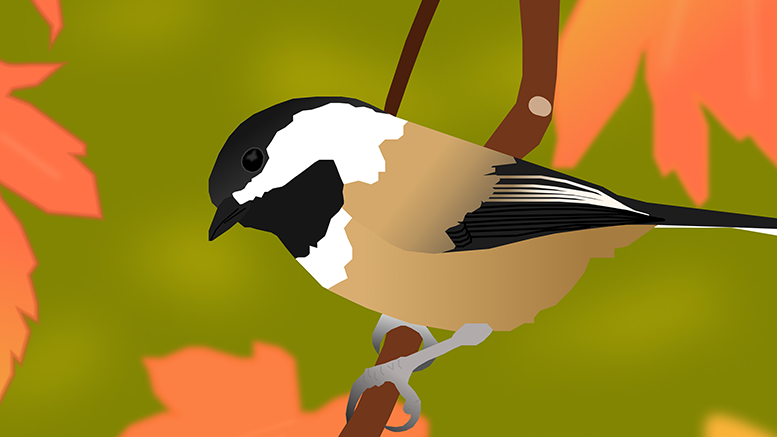Birds — you know them. You might have even seen a few. But have you ever taken a closer look?
One campus group has been doing just that since June 2023. The UM Indigenous Birding Club meets on Thursdays at 11:20 a.m. in front of the Louis Riel statue at Migizii Agamik – Bald Eagle Lodge. Their weekly birding walks run from the spring to the fall, this year from March to September. The club is open to U of M community members and birders of all experience levels — faculty, staff and students, experts and novices alike.
Co-lead and co-founder Justin Rasmussen had noticed increased social anxiety among students returning to in-person classes after the start of the pandemic. Inspired by the calming effect of nature, he and his bird-loving colleagues at the university wanted to share that experience with others.
“You feel less stressed after a bird walk and more ready for the day, [so] why not bring students and other staff along?” he said.
As a rookie birdwatcher myself, the sentiment was greatly appreciated. My interest in birding began with my introduction to the board game Wingspan. Its eye-catching illustrations and complex strategy hooked me instantly. With hundreds of hours of gameplay under my belt, I have come to know the bird cards like the back of my hand, but I craved a greater familiarity with their real-life counterparts.
Joining the club proved a great place to start. Experienced birders helped identify species I couldn’t and participants were provided with binoculars ahead of the weekly walk.
Kings Park is a frequent destination of the club’s walks, but it is not the only fruitful spot for nearby birdwatching. Rasmussen also cited the former golf course just north of Princess Auto Stadium and the birdfeeders at Migizii Agamik.
“Right on campus here, anywhere, we’ll see some really cool birds flying [overhead],” he said.
The bird depicted in the group’s logo, the black-capped chickadee, can be seen year-round in Winnipeg, while others vary by season. For instance, the indigo bunting — a favourite of club members Mary Kate Dennis and Simone Hernandez-Ramdwar — spends summer in eastern and central Canada before heading south for the winter.
Indeed, one of the pleasures of birding is in observing the subtle change of the seasons. Dennis noted that species like the American goldfinch and yellow-rumped warbler display striking plumage early in the year that dulls as autumn approaches. On our walk, Rasmussen was delighted to spy a black-and-white warbler, a bird that breeds in northern boreal regions and passes through southern Manitoba on its way to warmer southern climates.
A personal highlight for me was glimpsing another migratory bird, a juvenile Cooper’s hawk — poised, majestic, its beak wet and covered in feathers.
At one point, Rasmussen — with the help of the Merlin Bird ID app — alerted me to the call of a pileated woodpecker. This bird is a must-have in Wingspan — forming a nearly unbeatable combo when paired with the wood duck — so I was thrilled at the prospect of meeting an esteemed avian celebrity. Alas, we never managed to spot it.
I found out later that this is a common story among birders. Club member Muriel Houle heard a red-breasted nuthatch that likewise remained elusive.
“We haven’t seen an owl on a walk yet,” Rasmussen lamented. “There’s been screech-owls spotted at Kings Park and northern saw-whet owls that we haven’t seen on walks […] I’m always keeping my fingers crossed that we’ll eventually see one of those.” Hernandez-Ramdwar and Houle concurred.
But even the sight of the usual suspects can bring joy to a seasoned birder. A crucial component of the activity is learning to appreciate the world around you.
As Dennis put it, “there’s a lot of birds that get overlooked because they’re not fancy.”
The UM Indigenous Birding Club aims to promote inclusivity and sociability. To that end, their website stresses that the weekly walks “are all about sharing knowledge and building a sense of community. They are not lectures.”
To Rasmussen, “nature is everywhere.” Birdwatching in a public park can be a fun, accessible and relaxing hobby. “Even if you don’t have binoculars yet — you have a notepad and a pen — start recording your observations. Start learning one species at a time. Before you know it, you’ll know a whole bunch.”
“There’s lots and lots to learn,” said Dennis. “It never ends.”
The UM Indigenous Birding Club’s walks occur every Thursday from 11:30 a.m. to 1 p.m. through Sept. 26. For community members interested in going out on their own, the club loaned three pairs of binoculars to the science reserves kiosk in the Armes Link that any student or staff member can borrow for up to four days at a time. For more information, visit umindigenousbirdingclub.com.


